700 - 600
avant l’ère commune
Le prophète Jérémie à Jérusalem
The Prophet Jeremiah follows the prophet Isaiah as the leading prophet of his generation. In the years after the exile of the Northern Tribes by the Assyrians, the Kingdom of Judah was facing a new emerging world power: Babylon.
Sur la photo : Exemple de la façon dont une bulla, un sceau d'argile inscrit, était utilisée dans l'Antiquité pour imprimer une empreinte sur des documents.
Institut Megalim de la Cité de David

British Museum, Londres
Roi Manassé de Juda, règne 687-643 avant l’ère commune
Rois II 21 :1-3
Manassé avait douze ans lorsqu'il devint roi, et il régna cinquante-cinq ans à Jérusalem... Il a fait ce qui déplaisait à l’Eternel... Il reconstruisit les sanctuaires que son père Ézéchias avait détruits ; il érigea des autels pour Baal et fit un poste sacré...
Prisme B d'Esarhaddon
« Et moi (Esarhaddon) j'ai convoqué les rois... Ba'lu, roi de Tyr, Manassé, roi de Juda... J'ai envoyé des commandes à tous pour de grandes poutres... tout ce qu'il fallait pour mon palais...
King Hezekiah who married, Hephzibah, the daughter of the prophet
Isaiah, learned through prophecy that his sons would not follow in his righteous
footsteps. King Hezekiah died in 687 BCE and his son Manasseh succeeded
him as king of Judah, reigning until 643 BCE.
While King Hezekiah had purified religious observance, King
Manasseh rebuilt the idolatrous temples and altars that his father had
destroyed.
2 Kings 21:1-3 Manasseh was twelve
years old when he became king, and he reigned fifty-five years in Jerusalem… He
did what was displeasing to the L-RD… He rebuilt the shrines that his father
Hezekiah had destroyed; he erected altars for Baal and made a sacred post…
The Esarhaddon Prism B, a hexagonal, clay prism on
display in the British Museum, mentions King Manasseh, in a list of kings that
Esarhaddon, summoned to retrieve building materials for his palace at Nineveh. Esarhaddon
was the son of the Neo-Assyrian King Sennacherib.
“And I (Esarhaddon)
summoned the kings… Ba’lu, king of Tyre, Manasseh, king of Judah… I sent orders
to all of them for large beams…everything that was needed for my palace…”
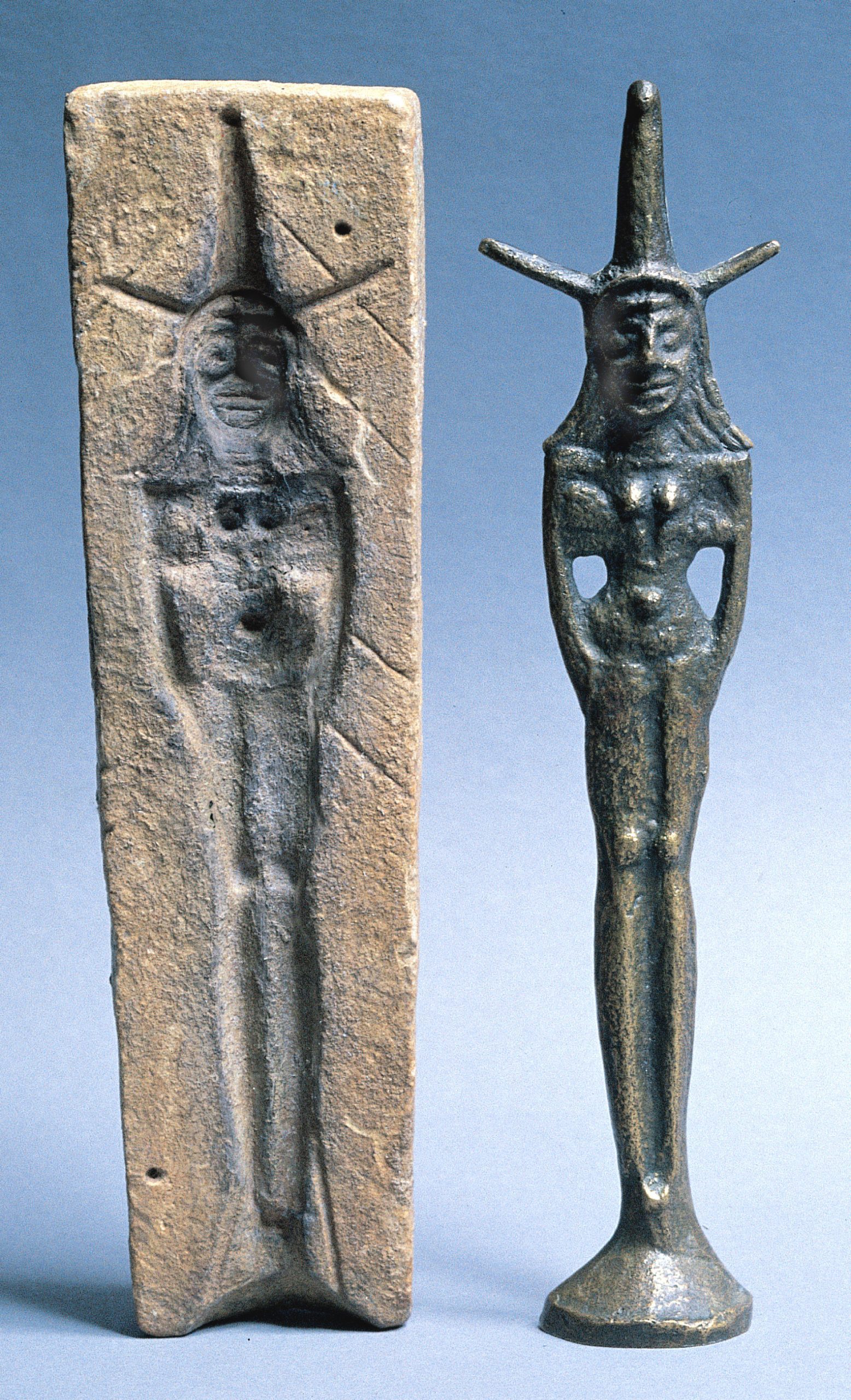
Astarté en bronze avec moule
Autorité des antiquités d'Israël / Musée d'Israël,
Photo de Zev Radovan
Iniquité du roi Manassé
Rois II 21 :6-7
... [Manassé] fit beaucoup de choses qui déplaisaient à l'Éternel pour l’irriter. L'idole sculptée d'Astarté qu'il avait faite, il l'a placée dans la Maison (le Temple).
The extent of King Manasseh’s wickedness is seen by him
placing a sculptured image of the pagan goddess Asherah in the Holy Temple.
2 Kings 21: 6-7
...[Manasseh] did
much that was displeasing to the L-RD, to vex Him. The sculptured image of
Asherah that he made, he placed in the House (the Temple).
Pictured here is a Bronze Asherah fertility idol with
the mold it was cast in, which can be viewed at the Israel Museum in
Jerusalem.
La première mention du shabbat, vers 650 avant l’ère commune
Ostracon de Mezad Hashavyahu
« Que mon seigneur le gouverneur entende la parole de son serviteur ! Ton serviteur est un faucheur. Ton serviteur était à Hazar Asam, et ton serviteur a moissonné, et il a terminé, et il a amassé (le grain) pendant ces jours avant le sabbat.
The Mezad Hashavyahu Ostracon, circa 650 BCE. Inscribed on the Ostracon is the
first mention of the Sabbath, outside of biblical text.
Ostraca are pottery sherds that were reused after the pot
was broken as a writing surface. Written on this piece is the appeal of a farm
worker whose garment was confiscated by a supervisor as collateral, on the
grounds that the worker failed to meet his daily quota of grain harvesting and
owed the rest. The worker claims that he did meet the quota.
"Let my lord,
the governor, hear the word of his servant! Your servant is a reaper. Your
servant was in Hazar Asam, and your servant reaped, and he finished, and he was
storing up (the grain) during these days before the Sabbath.”
The ostracon was excavated from a small Iron Age
fortress just south of modern-day Tel Aviv
Autorité des Antiquités d'Israël / Musée d'Israël
Roi Josias, règne 640-609 avant l’ère commune
Rois II 22 :1-2
Josias avait huit ans lorsqu'il devint roi, et il régna trente et un ans à Jérusalem... Il fit ce qui plaisait à l'Éternel et il suivit toutes les voies de son ancêtre David...
Chroniques II 34 :3
Dans la huitième année de son règne (632 avant l’ère commune), alors qu'il (Josias) était encore jeune, il commença à chercher le Dieu de son père David, et la douzième année (628 avant l’ère commune), il commença à purger Juda et Jérusalem des sanctuaires, des poteaux sacrés, des idoles et des statues.
King Josiah ruled from 640 -609 BCE. During his reign, he
started a great reform against the idolatrous ways of Amon his father, and
Manasseh his grandfather. He was guided by the pious High Priest Hilkiah and
his son, the prophet Jeremiah.
2 Kings 22:1-2 “Josiah was eight
years old when he became king, and he reigned for thirty-one years in
Jerusalem… He did what was pleasing to the L-RD and he followed all the ways of
his ancestor David…
2 Chronicles 34:3 In the eighth year of
his reign, while he was still young, he began to seek the G-d of his father
David, and in the twelfth year he began to purge Judah and Jerusalem of the
shrines, the sacred posts, the idols, and the molten images.”
Josias tenant son fils, Jechonias, Michel-Ange, Chapelle Sixtine
Le roi Josias célébra la Pâque et restaura l'Arche sainte dans le temple
Chroniques II 35 :1-3
Josias célébra la Pâque pour l'Eternel à Jérusalem...Il dit aux Lévites, consacrés à l'Éternel, qui enseignaient à tout Israël : « Mettez l'Arche sainte dans la maison que Salomon, fils de David, roi d'Israël, a bâtie...
During his reform, King Josiah renovated the Holy Temple and
restored the Ark of the Covenant to the Temple.
He gathered the inhabitants of Jerusalem and Judea in the Holy Temple.
There he read to them the message of the Holy scroll and solemnly vowed to
follow in the way of G‑d and to observe
His commands.
2 Chronicles 35:1-3 Josiah
kept the Passover for the L-RD in Jerusalem...
He said to the Levites, consecrated to the L-RD, who taught all Israel,
“Put the Holy Ark in the House that Solomon son of David, king of Israel,
built..."
Jérémie commence sa prophétie, vers 627 avant l’ère commune.
Jérémie 1 :2-3
La parole de l'Éternel fut adressée à Jérémie du temps du roi Josias, fils d'Amon de Juda, dans la treizième année de son règne, et sous le règne du roi Joiaqim, fils de Josias de Juda, et jusqu'à la fin de la onzième année du roi Sédécias, fils de Josias, roi de Juda, lorsque Jérusalem partit en exil (en Babylonie et en Égypte).
The Prophet Jeremiah began his prophecy around the time that
King Josiah was purging Judah of its idols, circa 627 BCE
Jeremiah 1:2-3
The word of the L-RD
came to Jeremiah in the days of King Josiah son of Amon of Judah, in the
thirteenth year of his reign, and throughout the days of King Jehoiakim son of
Josiah of Judah, and until the end of the eleventh year of King Zedekiah son of
Josiah king of Judah, when Jerusalem went into exile.
Michel-Ange, Chapelle Sixtine

Autorité des Antiquités d'Israël / Musée d'Israël Photo de Bruce Zuckerman, Projet de recherche sémitique de l'Ouest de l'USC
La bénédiction sacerdotale, la plus ancienne inscription biblique, datée de l'époque du roi Josias
Nombres 6 :24-25
Que l'Éternel te bénisse et te protège ; que l'Eternel fasse briller sa face sur toi et qu'Il te fasse grâce...
L'amulette du rouleau d'argent
« Que Y-H-V-H te bénisse et te garde.
Que Y-H-V-H fasse briller sa face...
Pictured here is a small silver scroll amulet, found in 1979, containing the oldest Biblical Inscription, dating back to the time of King Josiah. Two silver scrolls were found in a burial chamber together with other ancient artifacts in the Hinnom Valley, south of the ancient city of Jerusalem by archaeologist Gabi Barkay.
Included
in the engraved Hebrew text is the Priestly blessing found in Numbers 6:24-25
The L-RD will bless you and keep you;
The L-RD will shine His face upon you and
be gracious to you
The L-RD will turn His face towards you and
give you peace.
The Silver Scroll
Amulet reads: “May the L-RD bless you and may He keep
you.May the L-RD make His face shine...” The
Scroll is on display at the Israel Museum in Jerusalem
La découverte de la bénédiction sacerdotale
hors des murs de Jérusalem
Institut Megalim de la Cité de David Avec l'aimable autorisation
de George Blumenthal et de la famille Gol
In this video by the Megalim Institute, courtesy of George Blumenthal and the Gol family, you can learn more about the discovery of the two silver scrolls along with other great ancient treasures. The video further discusses the ancient burial practices as well as the idolatrous practices in the Valley of Hinnom that were uprooted in the time of King Josiah’s religious reform.
Sceaux Bulla
Une Bulla est une empreinte de sceau utilisée pour sceller des documents, soit une sorte d'authentification et d'inviolabilité. L'empreinte du sceau était généralement faite par une chevalière portant les lettres au revers afin que les lettres se lisent correctement lorsqu'elles sont imprimées sur un morceau d'argile.
Throughout the excavations in Israel, bullae or seal impressions were found, many times carrying names of Biblical figures.
A Bulla is a seal impression that was used to seal documents. Taa signet ring carrying the reverse letters so that the letters will read properly when impressed on a piece of clay.
These clay impressions would have eventually disintegrated after a few hundred years. However, the immense heat of the destruction of Jerusalem "baked" and hardened these seal impressions, preserving them, and making them discoverable in the present day.
Reçu d'un prêt de grains, papyrus scellé de la garnison juive d'Éléphantine, Égypte, 402 avant l’ère commune, Brooklyn Museum

Musée de la Bibliothèque nationale de France,
Photo de Zev Radovan
Hilkiya le grand prêtre découvre le livre du Deutéronome, vers 622 avant l’ère commune
Rois II 22 :3-8
Dans la dix-huitième année du règne de Josias... le souverain sacrificateur Hilkiya dit au scribe Schaphan : « J'ai trouvé un rouleau de l'Enseignement dans la Maison de l'Éternel ! »
Inscription de l'anneau
« Appartenant à Hanan, fils du prêtre Hilkiya »
You are looking at an ancient seal ring with the Inscription
“Belonging to Hanan, Son of Hilkiah the Priest”.
The dark blue agate seal is rare as it was found still
encased within its silver ring. The three-line inscription is in reverse
letters, as per usual, so that the letters will read properly when impressed on
a piece of clay, called a bulla.
The Bible relates how Hilkiah the High Priest discovered a
precious Torah scroll that scholars believe was the Book of Deuteronomy.
2 Kings 22:3-8 In the
eighteenth year of King Josiah…the high priest Hilkiah said to the scribe
Shaphan, “I have found a scroll of the Teaching in the House of the L-RD!”
Empreinte de sceau de Nathan-Melekh, serviteur du roi
Rois II 23 :11
[Le roi Josias] supprima les chevaux que les rois de Juda avaient consacrés au soleil, à l'entrée de la maison de l'Éternel, près de la salle de l'eunuque Nathan-Mélekh, qui était dans l'enceinte. Il brûla les chars du soleil.
In this picture is a clay impression of a seal that was
found in the City of David in 2019, bearing the name of Nathan-Melech. He is
believed to be one of the officials in King Josiah's court who assisted in
carrying out the King's religious reform.
The inscription on the clay impression reads:
“Belonging to Nathan-Melech, Servant of the King"
The Bible mentions Nathan Melech in 2 Kings 23:11:
[King
Josiah] did away with the horses that the kings of Judah had dedicated to the
sun, at the entrance of the House of the L-RD, near the chamber of the eunuch
Nathan-melech, which was in the precincts. He burned the chariots of the sun
Autorité des antiquités d'Israël / Cité de David
Photo d’Eliyahu Yanai
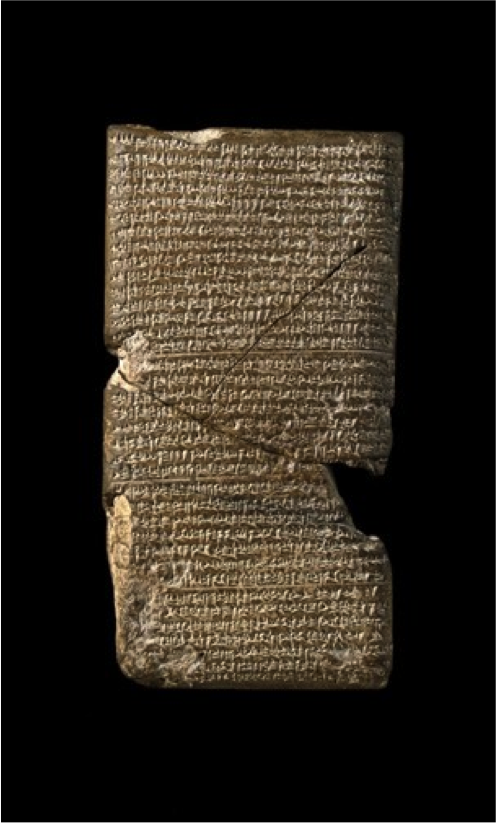
British Museum
Les Babyloniens détruisent la ville assyrienne de Ninive, 612 avant l’ère commune
Nahum 3 :18-19
Ô roi d'Assyrie...
Tous ceux qui entendent parler
de ta chute applaudissent...
La chute de Ninive dans la Chronique babylonienne
« ... (Nabopolassar, père de Nabuchodonosor II de Babylone) donna un assaut décisif à la ville (Ninive). ... Un grand massacre fut perpétré sur le peuple et les nobles.
Instability rocked the Assyrian empire, giving rise to the
Neo-Babylonian Empire in the northeast, and Egypt regaining power in the
southwest. Judah situated between them was to be destroyed in the ensuing
struggle in which the Babylonians eventually prevailed.
In the year 612 BCE the Babylonians destroyed the Assyrian
City of Nineveh.
The book of the Prophet Nahum chapter 3: verse 18-19 refers
to this: O king of Assyria…All who hear about
your (downfall) will clap their hands over you, for on whom has not your evil
passed continually?
The Fall of the city Nineveh is mentioned in one of the
Babylonian Chronicle clay tablets referring to Nabopolassar, the father of
Nebuchadnezzar II of Babylon:
“…a mighty assault he
made upon the city. …a great
slaughter was made of the people and nobles.”
Josias est mortellement blessé par les Égyptiens à Megiddo, vers 609 avant l’ère commune
Chroniques II 35:20-24
... Le roi Neco (II) d'Égypte monta pour combattre [contre les Babyloniens] à Karkemish sur l'Euphrate, et Josias partit à sa rencontre.
[Néco] lui envoya des messagers pour lui dire : « Qu'ai-je à faire avec toi, roi de Juda ? Je ne marche pas contre toi aujourd'hui, mais contre le royaume qui me fait la guerre...
Mais Josias n’écouta pas ses paroles ; au lieu de... il vint combattre dans la plaine de Megiddo. Des archers tirèrent sur le roi Josias, et le roi dit à ses serviteurs : « Éloignez-moi d'ici, car je suis grièvement blessé. »
Ses serviteurs... l'emmenèrent à Jérusalem. C'est là qu'il mourut et qu'il fut enterré dans le tombeau de ses pères, et tout Juda et Jérusalem prirent le deuil de Josias.
On his way to battle the Babylonians, King Neco II of Egypt
met with opposition from King Josiah. In
the plains of Meggido, the two armies battled, and the Judean troops were
defeated. The book of Chronicles tells the story:
2 Chronicles 35:20-24 ...King Neco of Egypt came up to fight [against the
Babylonians] at Carchemish on the Euphrates,
and Josiah went out against him. [Neco] sent
messengers to him, saying, “What have I to do with you, king of Judah? I do not
march against you this day but against the kingdom that wars with me... But Josiah would not
let him alone; instead… he came to fight in the plain of Megiddo. Archers shot
King Josiah, and the king said to his servants, “Get me away from here, for I
am badly wounded.” His servants...conveyed
him to Jerusalem. There he died and was buried in the grave of his fathers, and
all Judah and Jerusalem went into mourning over Josiah.

Société d'archéologie biblique
Le pharaon Neco II couronne Joiaqim, roi de Juda, vers 609 avant l’ère commune
Chroniques II 36 :1-4
Le peuple du pays prit Joachaz, fils de Josias, et le fit roi à Jérusalem à la place de son père
Joachaz avait vingt-trois ans lorsqu'il devint roi, et il régna trois mois à Jérusalem. Le roi d'Égypte (Neco II) le détrôna à Jérusalem et imposa à Juda une levée de cent talents d'argent et d'or.
Alors Neco (II), roi d'Égypte, établit Éliakim, frère de Joachaz, roi de Juda et de Jérusalem, et il changea le nom d'Éliakim en Joiaqim. Mais Neco prit Joachaz, frère d'Éliakim, et l'emmena en Égypte.
You are looking at a bronze statue of Pharaoh Neco II,
displayed in the Penn Museum, Philadelphia.
King Josiah designated his second son Jehoahaz as his
successor to the throne. After his death, the people proclaimed Jehoahaz king,
but his reign lasted only three months. During that time he provoked the wrath
of King Necho II of Egypt, and Necho advanced upon the land of Israel, attacked
and captured Jehoahaz. He took him in fetters to Egypt where he died in
captivity. King Necho placed Jehoahaz's brother, Eliakim, on the throne, and
changed his name to Joiakim.
2 Chronicles 36:1-4 Then the people of
the land took Jehoahaz son of Josiah and made him king in Jerusalem in place of
his father. Jehoahaz was
twenty-three years old when he became king, and he reigned in Jerusalem three
months. And the king of Egypt dethroned him in Jerusalem and imposed on Judah a
levy of a hundred talents of silver and a talent of gold. Then
Neco, king of Egypt made Eliakim, brother of Jehoahaz, king over Judah and
Jerusalem, and he changed Eliakim’s name to Jehoiakim. But Neco took Eliakim’s
brother Jehoahaz and carried him off to Egypt.
Statue en bronze du pharaon Neco II,
Penn Museum, Philadelphie
Nebuchadnezzar's First Campaign, 605 BCE
Jeremiah 46:2
Of Egypt: concerning the army of Pharaoh-Neco king of Egypt, which was by the river Euphrates in Carchemish, which Nebuchadnezzar king of Babylon smote in the fourth year of Jehoiakim the son of Josiah, king of Judah.
Nebuchadnezzar Chronicle:
"In the 21st year of the king of Akkad (Nabopolassar) stayed in his own land, and Nebuchadnezzar his eldest son, the crown-prince mustered the Babylonian army... he marched to Carchemish...crossed the river to go against the Egyptian army... Nebuchadnezzar conquered the whole area of Hamath..."
Continuing his father, Nabopolassar's war campaigns,
Nebuchadnezzar II pushed westward from Nineveh to Haran while Egyptian Pharaoh
Necho moved his armies, crossing the Land of Israel to oppose Nebuchadnezzar in
the north. Nebuchadnezzar defeated Necho at the Battle of Carchemish in 605
BCE.
Jeremiah 46:2 Of Egypt: concerning the army of Pharaoh-neco king of
Egypt, which was by the river Euphrates in Carchemish, which Nebuchadrezzar
king of Babylon smote in the fourth year of Jehoiakim the son of Josiah, king
of Judah.
Nebuchadnezzar Chronicle: "In the 21st year of the king of Akkad
(Nabopolassar) stayed in his own land, and Nebuchadnezzar his eldest son, the
crown-prince mustered the Babylonian army... he marched to Carchemish...crossed
the river to go against the Egyptian army... Nebuchadnezzar conquered the whole
area of Hamath..."
Biblical Archaeology Society
The Royal Quarter and
Bullae House
Jeremiah 36:25-26
...Elnathan, Delaiah, and Gemariah begged the king not to burn the scroll, but he would not listen to them. The king ordered Jerahmeel, the king’s son, and Seraiah son of Azriel, and Shelemiah son of Abdeel, to arrest the scribe Baruch and the prophet Jeremiah.
This video by the Megalim Institute, covers the period of
King Jehoiakim's reign, from 609 to 598 BCE, the Babylonian advance on Judea,
and how King Jehoiakim brazenly destroyed the scroll containing Jeremiah's
prophecy and warnings.
Remarkably, the video details the discovery of clay
seal impressions containing the names of key figures mentioned in the Bible,
providing further proof of the Bible's historical validity.
City of David Megalim Institute
Courtesy of George Blumenthal and the Gol Family
King Jehioakim Cuts the Scroll of Jeremiah's Pronouncement
Jeremiah 36:21, 23
The king sent Jehudi to get the scroll and he fetched it from the chamber of the scribe Elishama. Jehudi read it to the king and to all the officials who were in attendance on the king...
And every time Jehudi read three or four columns, the king would cut it up with a scribe’s knife and throw it into the fire in the brazier, until the entire scroll was consumed by the fire in the brazier.
In 2016, a rare papyrus document was discovered, dating to the 7th Century BCE. This document contained earliest known extra-biblical reference to Jerusalem written in Hebrew writing. The papyrus is much like the one that King Jehioakim would have cut and thrown into the fire.
Oldest Written Mention of Jerusalem in Hebrew, 7th Century BCE
“From the female servant of the king, from Naharata (a place near Jericho) two wineskins to Jerusalem.”
Jehioakim, Josiah's son, was a violent, corrupt and greedy
king who robbed the common people from their money. Jeremiah's words against
this corruption are documented by his scribe Baruch Ben Neriyah and read before
the people. The document reaches Jehioakim and he furiously tears it up and throws
it into the fire.
Jeremiah 36:23 And every time Jehudi read three or four columns, the
king would cut it up with a scribe’s knife and throw it into the fire in the
brazier, until the entire scroll was consumed by the fire in the brazier.
In this picture is a rare papyrus document that was
discovered in 2016, dating to the 7th Century BCE. It contains the earliest known extra-biblical
reference to Jerusalem written in Hebrew.
The papyrus is much like the one that King Jehioakim would have cut and
thrown into the fire.
Written in ancient Hebrew script it reads as follows: “From the female servant of the king, from Naharata, two
wineskins to Jerusalem.”
The town Naarah is referred to in Joshua 16:7 as being
located on the border of Ephraim and Benjamin.
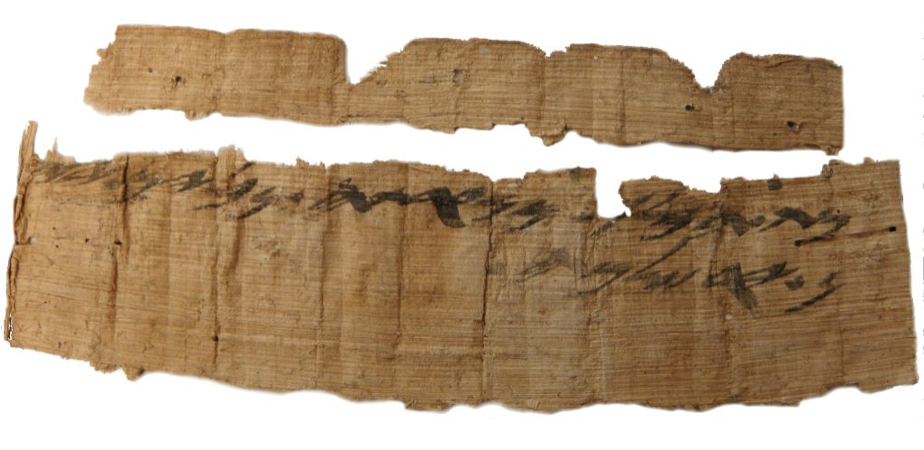
Israel Antiquities Authority
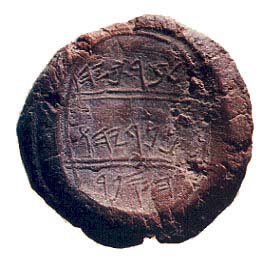
Israel Antiquities Authority / Israel Museum,
Photo by David Harris
"Baruch, the Son of Neriyahu, the Scribe," Seal Impression, c. 605 BCE
Jeremiah 36:1, 4
In the fourth year of King Jehoiakim son of Josiah of Judah, this word came to Jeremiah from the L-RD: Get a scroll and write upon it all the words I have spoken to you concerning Israel…
Jeremiah called Baruch son of Neriah (Neriyahu); and Baruch wrote down in the scroll, at Jeremiah’s dictation, all the words which the L-RD had spoken to him.
In this picture is a bulla or seal impression reading: Baruch, the Son of Neriyahu, the Scribe circa 605 BCE. It was found in 1996. Jeremiah's faithful scribe Baruch Ben Neriya is mentioned throughout the book of Jeremiah and was also subjected to the assault and abuse of the court officials. Baruch later became the mentor of Ezra the Scribe in Babylon. Not only did Baruch write the scroll that King Jehoiakim threw into the fire, but also the scroll with the deed confirming Jeremiah's purchase of land on the eve of the destruction, signifying G-d’s promise of the Jewish people's ultimate Return to Zion. On the edge of the bulla is a fingerprint, presumably that of Baruch. Jeremiah 32: 13-15 And I charged Baruch before them, saying: 'Thus saith the L-RD of hosts, the G-d of Israel: Take these deeds, this deed of the purchase, both that which is sealed, and this deed, which is open, and put them in an earthen vessel; that they may continue many days. For thus saith the L-RD of hosts, the G-d of Israel: Houses and fields and vineyards shall yet again be bought in this land.'
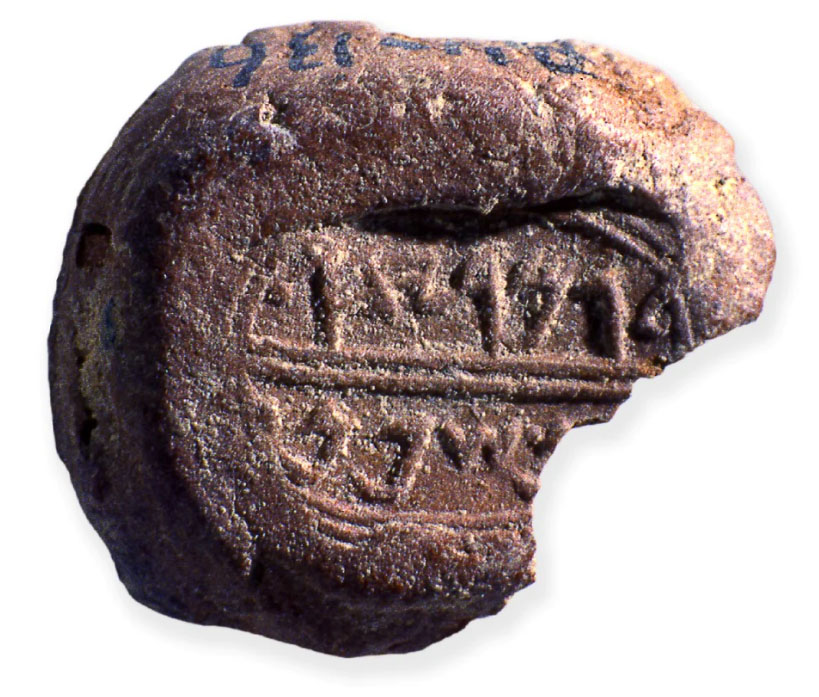
Israel Museum / Israel Antiquities Authority / City of David
"Gemaryahu,
Son of Shaphan"
Seal Impression, c. 604 BCE
Jeremiah 36:9-10
In the ninth month of the fifth year of King Jehoiakim son of Josiah of Judah, all the people in Jerusalem and all the people coming from Judah proclaimed a fast before the L-RD in Jerusalem.
It was then that Baruch—in the chamber of Gemariah (Gemaryahu) son of Shaphan the scribe, in the upper court, near the new gateway of the House of the L-RD—read the words of Jeremiah from the scroll to all the people in the House of the L -RD.
A prominent scribe mentioned in the book of Jeremiah is
Gemariah, whose seal impression was found in the City of David excavations.
The seal impression reads: "Gemaryahu, Son of
Shapan"
Jeremiah 36:10
It was
then that Baruch in the chamber of Gemariah son of Shaphan the scribe, in the
upper court, near the new gateway of the House of the L-RD, read the words of
Jeremiah from the scroll to all the people in the House of the L-RD.

Temple Mount Sifting Project, Photo by Zachi Zweig
Bulla Seal from
First Temple Priest Immer
Jeremiah 20:1
Pashhur son of Immer, the priest who was chief officer of the House of the L-RD, heard Jeremiah prophesy these things.
Bulla Inscription, 7th Century BCE
“Belonging to Galyahu [son of] Immer.”
The Immers were a well-known family of priests at the end of the First Temple period. Pashur ben Immer is mentioned in Jeremiah 20:1. Archaeologist Tzahi Dvira said, “This seal was used to stamp luxury items that were kept in the treasury of the Temple, which was administered by the priests. This stamp seal is the first Hebrew inscription that was ever discovered from the First Temple and constitutes direct evidence of the administrative activity of the First Temple priests.”
Pictured here is a seal impression dating to the 7th century
BCE. The inscription reads: “Belonging to Galyahu [son of] Immer.” dating to
the 7th century BCE. Immer's other son, Pashur, is mentioned in Jeremiah 20:1
Pashhur son of Immer, the priest who was chief officer of
the House of the L-RD, heard Jeremiah prophesy these things.
The Immers were a well-known family of priests at the
end of the First Temple period.
Archaeologist Tzahi Dvira of the Temple Mount sifting project said,
“This seal was used to stamp luxury items that were kept in the treasury of the
Temple, which was administered by the priests. This stamp seal is the first
Hebrew inscription that was ever discovered from the First Temple and
constitutes direct evidence of the administrative activity of the First Temple
priests.”
created with
WordPress Website Builder .